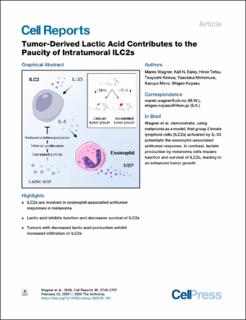| dc.contributor.author | Wagner, Marek | |
| dc.contributor.author | Ealey, Kafi N | |
| dc.contributor.author | Tetsu, Hiroe | |
| dc.contributor.author | Kiniwa, Tsuyoshi | |
| dc.contributor.author | Motomura, Yasutaka | |
| dc.contributor.author | Moro, Kazuyo | |
| dc.contributor.author | Koyasu, Shigeo | |
| dc.date.accessioned | 2021-07-07T12:01:33Z | |
| dc.date.available | 2021-07-07T12:01:33Z | |
| dc.date.created | 2021-02-15T12:32:30Z | |
| dc.date.issued | 2020 | |
| dc.identifier.issn | 2211-1247 | |
| dc.identifier.uri | https://hdl.handle.net/11250/2763785 | |
| dc.description.abstract | Group 2 innate lymphoid cells (ILC2s) are abundant in non-lymphoid tissues and increase following infectious and inflammatory insults. In solid tumors, however, ILC2s constitute a relatively small proportion of immune cells. Here, we show, using melanoma as a model, that while the IL-33/IL C2/eosinophil axis suppresses tumor growth, tumor-derived lactate attenuates the function and survival of ILC2s. Melanomas with reduced lactate production (LDHAlow) are growth delayed and typified by an increased number of ILC2s compared with control tumors. Upon IL-33 stimulation, ILC2s accompanied by eosinophils more effectively restrain the growth of LDHAlow tumors than control melanomas. Furthermore, database analysis reveals a negative correlation between the expression of LDHA and markers associated with ILC2s and the association of high expression of IL33 and an eosinophil marker SIGLEC8 with better overall survival in human cutaneous melanoma patients. This work demonstrates that the balance between the IL-33/ILC2/eosinophil axis and lactate production by tumor cells regulates melanoma growth. | en_US |
| dc.language.iso | eng | en_US |
| dc.publisher | Elsevier | en_US |
| dc.rights | Navngivelse 4.0 Internasjonal | * |
| dc.rights.uri | http://creativecommons.org/licenses/by/4.0/deed.no | * |
| dc.title | Tumor-Derived Lactic Acid Contributes to the Paucity of Intratumoral ILC2s | en_US |
| dc.type | Journal article | en_US |
| dc.type | Peer reviewed | en_US |
| dc.description.version | publishedVersion | en_US |
| dc.rights.holder | Copyright 2020 the authors | en_US |
| cristin.ispublished | true | |
| cristin.fulltext | original | |
| cristin.qualitycode | 1 | |
| dc.identifier.doi | 10.1016/j.celrep.2020.01.103 | |
| dc.identifier.cristin | 1889865 | |
| dc.source.journal | Cell reports | en_US |
| dc.source.pagenumber | 2743-2757 | en_US |
| dc.identifier.citation | Cell reports. 2020, 30 (8), 2743-2757. | en_US |
| dc.source.volume | 30 | en_US |
| dc.source.issue | 8 | en_US |

